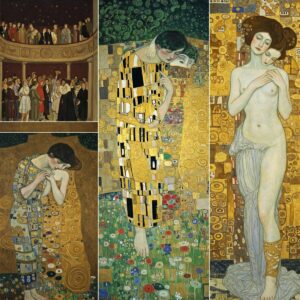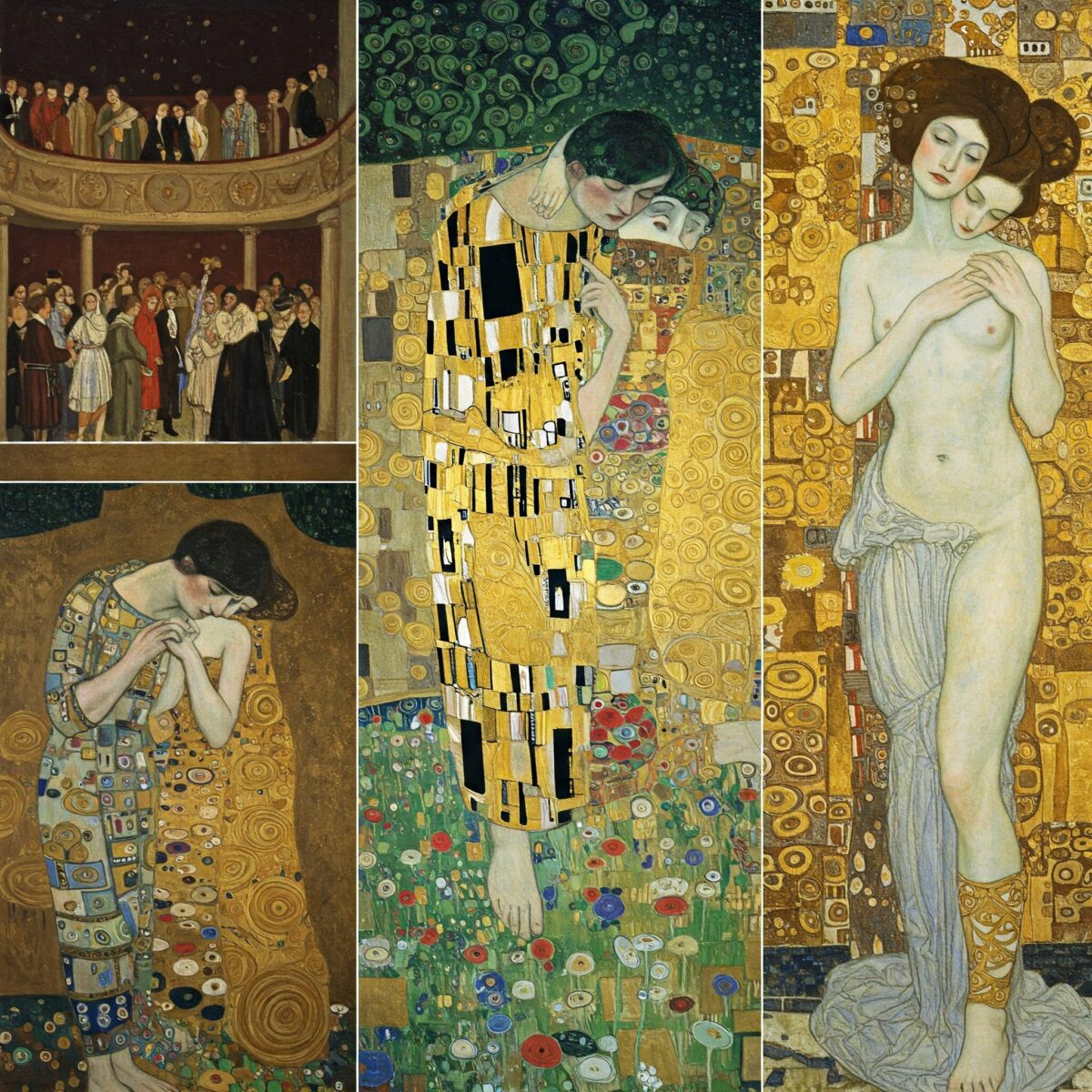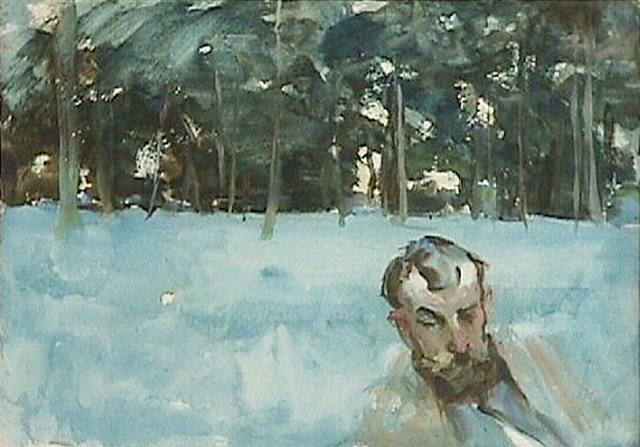Let’s dive into the glittering world of an artist who truly made gold his signature! We’re talking about the one and only Gustav Klimt. His work is like stepping into a dream filled with shimmering gold, beautiful patterns, and deep feelings. If you’ve ever seen one of his famous pieces, you know that Gustav Klimt paintings are unforgettable. They grab your attention with their sparkle and make you wonder about the stories hidden within the swirls and symbols. Get ready to explore the magic behind the man, his unique style, and why his art still fascinates us over a hundred years later!
Key Points Summary:
- Who: Gustav Klimt (1862-1918) was a famous Austrian painter known for his decorative, symbolic style.
- What: He created iconic Gustav Klimt paintings, especially during his “Golden Phase,” using real gold leaf.
- Style: His work is linked to the Art Nouveau movement (also called Jugendstil in German-speaking countries) and Symbolism in art.
- Famous Works: Includes “The Kiss,” “Portrait of Adele Bloch-Bauer I,” and “The Tree of Life.”
- Why Gold?: Influenced by Byzantine mosaics and his father’s work as a gold engraver, Klimt used gold to create a rich, almost spiritual effect.
- Legacy: Klimt was a leader of the Vienna Secession, challenging traditional art and influencing modern art.
Who Was Gustav Klimt? An Artist Breaking the Mold
Imagine Vienna, Austria, around the turn of the 20th century (fin de siècle). It was a city buzzing with new ideas in music, science, and art. Gustav Klimt (born 1862, died 1918) was right in the middle of it all. He started as a talented painter doing traditional work, like decorating fancy buildings. But Klimt wasn’t content staying within the lines. He felt art needed to break free from old rules.
He became a key figure in Austrian art and a leader of a group called the Vienna Secession. Think of them as rebels with paintbrushes! They wanted art to be fresh, modern, and full of personal expression. They even had a motto:
“To every age its art, to every art its freedom.”
This spirit pushed Klimt to develop the unique style that made his Gustav Klimt paintings so revolutionary. He became a central figure in what’s known as Viennese modernism.
The Vienna Secession: A New Dawn for Art
The Vienna Secession movement, founded in 1897 with Klimt as its first president, was a big deal. It was like saying “goodbye” to the stuffy, old-fashioned art academies and “hello” to something new and exciting. They weren’t just painters; architects and designers joined too. They wanted to bring all forms of art together, embracing the Art Nouveau style (or Jugendstil as it was known locally).
This style loved flowing lines, patterns inspired by nature, and a decorative feel. Klimt’s work during this time started to change. He experimented more, moving away from realistic paintings towards something more symbolic and ornamental. A great example of this early Secession work is his Beethoven Frieze.

Created for a Secession exhibition celebrating the composer Beethoven, this massive wall painting is an allegorical painting. It tells a story using symbols and figures representing things like happiness, suffering, and desire. You can see Klimt’s signature elongated figures and the beginnings of his love affair with gold accents. It shows how he was merging painting, decoration, and deep ideas – a hallmark of the Vienna Secession Klimt paintings analysis.
The Shimmering World of Gustav Klimt Paintings: The Golden Phase
When people think of Gustav Klimt paintings, they often picture the dazzling works from his “Golden Phase.” This period, roughly from the late 1890s to about 1910, is when he fully embraced his most famous technique: using real gold leaf in his paintings.
But why gold? Several things inspired him:
- His Father: Klimt’s father was a gold engraver, so working with precious metals was familiar.
- Byzantine Mosaics: A trip to Ravenna, Italy, in 1903 blew Klimt away. He saw ancient churches decorated with stunning gold mosaics from the Byzantine era. The way they shimmered and seemed almost heavenly deeply influenced him. You can see this Byzantine mosaics influence in the flat, patterned backgrounds of his golden works.
- Symbolic Power: Gold wasn’t just shiny; it represented richness, preciousness, and maybe even something spiritual or divine. It made his subjects look almost like icons.
Klimt didn’t just slap gold paint on. He used actual thin sheets of gold leaf, applying them carefully to the canvas alongside oil paints. This gold leaf technique created textures and a glow that paint alone couldn’t achieve. The famous gold leaf paintings by Gustav Klimt seem to radiate light.
Let’s look at some of the most famous examples from Klimt’s golden phase paintings collection:
The Kiss (1907-1908): An Icon of Love

This is probably Klimt’s most famous painting, recognized worldwide. “The Kiss” shows a couple locked in a passionate embrace, wrapped in golden robes, kneeling in a field of flowers. It’s a perfect example of Gustav Klimt Art Nouveau style characteristics – the flowing lines, the decorative patterns, and the blend of realism (the faces and hands) with abstraction (the robes and background).
The symbolism in Gustav Klimt The Kiss painting is powerful. It’s about the overwhelming power of love and connection, a moment where the couple seems lost in their own shimmering world. Notice the patterns: the man’s robe has strong, rectangular shapes, while the woman’s is filled with soft circles and floral designs. This contrast might symbolize the difference between masculine and feminine energy coming together. The erotic art elements are present too, but handled with tenderness rather than being explicit. This painting truly captures the essence of Symbolism in art, where images stand for deeper ideas and emotions. You can learn more about Symbolism in Art here.
Portrait of Adele Bloch-Bauer I (1907): The Woman in Gold

This stunning portrait is often called “The Woman in Gold” or “The Golden Lady.” It shows Adele Bloch-Bauer, the wife of a wealthy Jewish sugar producer who was a patron of Klimt’s art. She seems to float in a sea of gold and intricate patterns. Look closely, and you’ll see symbols like eyes (perhaps inspired by Egyptian art) and swirling shapes mixed with geometric forms.
This portrait of adele bloch-bauer gold lady painting is a prime example of Klimt’s unique approach to female portraiture. He captures Adele’s likeness – her delicate face and hands – but surrounds her with such rich decoration that she becomes almost part of the pattern. It’s a fascinating blend of a person and pure ornament, showcasing both her status and perhaps a sense of mystery. This painting also has a dramatic history involving Nazi looting and a long legal battle for its return, famously told in the movie “Woman in Gold.” Discover more about famous portraits here.
The Tree of Life (1909): A Swirling Symbol
Part of a commission for the Stoclet Palace in Brussels, “The Tree of Life” is another key work using the tree of life motif. Its swirling, golden branches reach across the canvas, filled with intricate patterns, flowers, and even a bird. It feels both decorative and deeply meaningful.

The Klimt tree of life symbolism and meaning connects to many cultures. It often represents connection between heaven, earth, and the underworld, as well as growth, family, and the cycle of life and death. Klimt’s version feels mystical and luxurious, blending nature with his signature decorative style. Notice the influence of Japanese art influence here, particularly in the flattened perspective and the way the branches create patterns, reminiscent of Japanese prints which were very popular in Europe at the time.
Symbolism, Style, and Influences in Gustav Klimt Paintings
Klimt wasn’t just making pretty pictures. His work is packed with symbolism in art. He explored big themes: life, death, love, desire, and the human psyche.
- Key Stylistic Elements:
- Gold Leaf: His signature, adding richness and a spiritual feel.
- Decorative Patterns: Intricate swirls, geometric shapes, floral motifs often inspired by different cultures (Byzantine, Egyptian, Japanese).
- Symbolism: Using figures and objects to represent deeper ideas (e.g., snakes for sensuality, skulls for death in paintings like Death and Life).
- Female Form: Klimt was fascinated by women, portraying them as powerful, mysterious, sensual, and sometimes dangerous (femme fatales). His female portraiture is iconic.
- Erotic Elements: Many Gustav Klimt paintings explore sensuality and erotic art elements, sometimes subtly, sometimes more openly, which often caused controversy.
- Flatness & Ornament: Combining realistic faces/bodies with flat, highly decorative backgrounds and clothing, influenced by Japanese art influence and mosaics.
“All art is erotic.”
Gustav Klimt
This quote gives insight into how Klimt viewed the connection between art, beauty, and human desire.
Controversy and Challenges
Klimt wasn’t always celebrated. His work often pushed boundaries and shocked people.
- University of Vienna Ceiling Paintings: In the early 1900s, Klimt was commissioned to paint murals for the University of Vienna’s Great Hall, representing Philosophy, Medicine, and Jurisprudence. His symbolic, sometimes dark, and sensual interpretations were deemed scandalous and pessimistic. Critics hated them, and the paintings were ultimately rejected and never installed. Sadly, they were later destroyed in a fire during World War II. This controversy marked a turning point, pushing Klimt towards private commissions where he had more freedom.
- Eroticism: The frank depiction of nudity and sensuality in many of his drawings and paintings challenged the conservative society of Vienna, leading to accusations of indecency. Why was Gustav Klimt controversial? Largely because he wasn’t afraid to explore the complexities of human desire visually.
Klimt’s Lasting Influence
Despite the controversies, Klimt’s impact on art was immense.

- Modern Art Pioneer: As a leader of the Vienna Secession, he helped break away from academic traditions, paving the way for modern art.
- Influence on Others: He mentored younger artists, most notably Egon Schiele, whose expressive and often unsettling work carries echoes of Klimt’s linearity and psychological depth. You can explore more about Modern Art Movements here.
- Enduring Appeal: The sheer beauty, decorative richness, and emotional depth of Gustav Klimt paintings continue to captivate audiences worldwide. His style is instantly recognizable and widely reproduced.
Where Can You See Gustav Klimt Paintings Today?
If you want to experience the magic of Klimt’s work in person, here are some key museums:
- The Belvedere Museum, Vienna: Holds the world’s largest collection of Klimt’s oil paintings, including “The Kiss” and “Judith I.”
- Neue Galerie, New York: Home to the stunning “Portrait of Adele Bloch-Bauer I.”
- Leopold Museum, Vienna: Features important works like “Death and Life” and studies for the University paintings.
- The Museum of Modern Art (MoMA), New York: Holds paintings like “Hope II.”
Check museum websites before visiting, as collections can change.
Watch: A Glimpse into Klimt’s World
Want a quick visual dive into Klimt’s golden art? This video offers a great introduction:
Frequently Asked Questions (FAQ)
Q1: When did Gustav Klimt live and work?
- Gustav Klimt lived from 1862 to 1918. He was most active as an artist in Vienna from the late 19th century until his death.
Q2: What inspired Klimt’s golden phase?
- Klimt’s golden phase was inspired by several factors: his father’s work as a gold engraver, the breathtaking Byzantine mosaics he saw in Ravenna, Italy, and the symbolic power of gold to represent richness, spirituality, and preciousness.
Q3: How much are Gustav Klimt paintings worth today?
- Gustav Klimt paintings are among the most valuable in the world. Major works can sell for tens or even hundreds of millions of dollars. For example, “Portrait of Adele Bloch-Bauer I” was famously acquired by the Neue Galerie for a reported $135 million in 2006.
Q4: Why was Gustav Klimt controversial?
- Klimt was controversial mainly because his work challenged traditional artistic norms and societal morals. His University of Vienna paintings were rejected for their perceived pessimism and nudity, and the erotic themes in many of his works were considered scandalous at the time.
Q5: What is the meaning behind “The Kiss” painting?
- “The Kiss” is widely interpreted as a powerful symbol of love, intimacy, and the transcendence of romantic connection. The golden aura suggests a sacred or magical moment, while the contrasting patterns on the figures’ robes might symbolize the union of masculine and feminine energies. It embodies the peak of his Symbolism in art.
Q6: How did Klimt influence modern art?
- Klimt was a key figure in the Vienna Secession and Art Nouveau movements, which broke from academic tradition. His emphasis on decoration, symbolism, psychological depth, and his innovative style influenced many artists, including Egon Schiele, and contributed to the development of Expressionism and modern art.
Q7: Connection between Klimt and Egon Schiele?
- Klimt was a mentor and supporter of the younger artist Egon Schiele. While Schiele developed his own distinct, more angular and psychologically intense style, Klimt’s influence can be seen in Schiele’s expressive lines and focus on the human figure.
Q8: What museums feature Gustav Klimt collections?
- Major collections are found at the Belvedere Museum and Leopold Museum in Vienna, Austria, and the Neue Galerie in New York City. Other museums like MoMA also hold significant works.
Q9: Why did Klimt use gold leaf in his paintings?
- Klimt used gold leaf technique to add literal richness and a shimmering, otherworldly quality to his paintings. It connected to historical art forms like Byzantine mosaics, elevated the decorative aspects of his work, and added layers of symbolic meaning related to value, luxury, and spirituality.
Q10: Was Gustav Klimt part of any art movement?
- Yes, Gustav Klimt was a leading figure in the Vienna Secession movement and is strongly associated with Art Nouveau (or Jugendstil) and Symbolism in art. His work represents a bridge between 19th-century traditions and 20th-century modern art.
Gustav Klimt was more than just a painter who liked gold. He was a visionary who blended beauty, symbolism, and decoration in a way no one had before. His art invites us into a world that is both luxurious and deeply human. Exploring Gustav Klimt paintings is like uncovering treasures – each pattern, each color, each gaze holds a piece of a fascinating story. His shimmering legacy continues to inspire and enchant, proving that great art truly is golden.



